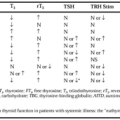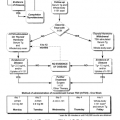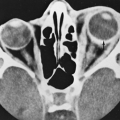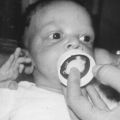DIAGNOSTIC EVALUATION OF THE THYROID NODULE
Part of “CHAPTER 39 – THE THYROID NODULE“
Because most thyroid nodule morbidity is related to cancerous lesions, clinical evaluation focuses on the identification of malignant nodules. Numerous methods have evolved to better define the probability of cancer in a given lesion.
HISTORY AND PHYSICAL EXAMINATION
The single most important historical risk factor for cancer is irradiation. The age at exposure, the type and site of therapy, and, if possible, the radiation dose to the thyroid should be determined. A family history of pheochromocytoma, hypercalcemia, mucosal abnormalities, or medullary thyroid carcinoma should raise suspicion of the latter diagnosis as part of the multiple endocrine neoplasia syndrome (see Chap. 188). A family history of benign goiter may be reassuring, although the rare Pendred syndrome (familial goiter and deafmutism) is associated with a higher cancer risk.1,3 Nodules in men are more likely to be malignant than those in women; nodules in children are more likely to be malignant than those in adults. The diagnosis of thyroid lymphoma should be considered in patients with a previous diagnosis of Hashimoto thyroiditis, especially in women older than 50 years of age.
The following clinical findings are thought to be more common in malignant than benign nodules: a history of radiation therapy, a family history of multiple endocrine neoplasia type 2A or 2B, rapid growth, hoarseness, pain, dysphagia, respiratory obstructive symptoms, and growth of the nodule despite T4 medication; and physical examination findings of cervical lymphadenopathy, firmness, documented nodule growth, vocal cord paralysis, fixation, and Horner syndrome. In general, signs and symptoms alone are not sufficiently sensitive or specific to allow selection of candidates for surgery. However, patients with advanced disease may present with lymphadenopathy, recent growth of hard nodules, and vocal cord paralysis, all of which suggest malignancy; the presence of obstructive symptoms is less reliable.1,39 As indicated, identification of a single nodule renders the patient at higher risk than does multinodularity.40
LABORATORY TESTS
The commonly used blood thyroid function tests often are of limited value in the evaluation of thyroid nodules. Functional thyroid parameters, including serum T3 and T4 or TRH stimulation (see Chap. 15 and Chap. 33) are useful in evaluating possible toxic adenomas. Thyroglobulin levels may be elevated in patients with thyroid malignancy but do not differentiate malignant adenomas from benign adenomas or from thyroiditis.41,42 Serum levels of antithyroglobulin and antimicrosomal antibodies also are of limited value.1,3 An increased basal plasma calcitonin level is reasonably sensitive and specific for medullary thyroid carcinoma in the setting of a thyroid nodule, although abnormal calcium and pentagastrin stimulation tests or detection of mutations in the ret protooncogene provide the greatest sensitivity43 (see Chap. 40, Chap. 53 and Chap. 188). In one large series, an elevated plasma calcitonin level was found in 0.5% of all patients with thyroid nodules and in 15.7% of those with thyroid carcinomas, a finding that led the authors to recommend routine measurement in the evaluation of thyroid nodules.44 Serum carcinoembryonic antigen levels are also elevated in most patients with medullary thyroid carcinoma, but they may be increased in patients with other thyroid carcinomas as well.1,4,7,45 None of these tests intended to detect medullary thyroid carcinoma is cost-effective for the initial evaluation of the nodular thyroid.
Stay updated, free articles. Join our Telegram channel

Full access? Get Clinical Tree







